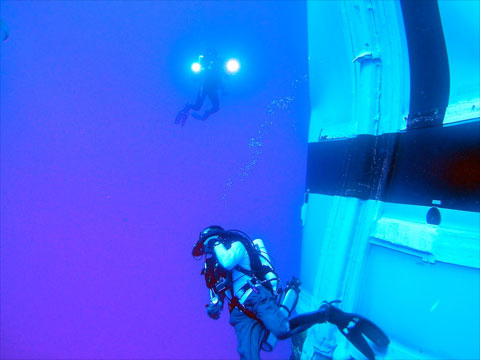NASA: Test Rocket Damage Caused by Parachute Failure

This story was updated at 4:50 p.m. ET.
NASA engineers still aren't sure what went wrong with a pairof parachutes that failed during Wednesday's Ares I-X rocket test flight,causing damage to the spent booster when it splashed into the Atlantic Oceanharder than planned.
"There was an indication that we had a parachuteproblem," said Ares I-X mission manager Bob Ess on Friday."Afterward, when we saw the parachutes we assumed, properly, that [therocket] must have hit harder than it should have."
Ares I-X's first stage solid rocket booster was equippedwith three giant 150-foot (46-meter) parachutes. One completely failed todeploy, while one appeared to open about half way, Ess said. The result: Thebooster was falling faster than expected when it hit the sea, so it buckledunder the pressure and dented.
Engineers are poring through the copiousdata returned from the $445 million testlaunch to discover the root of the issue, but said they're not too worried.
"Damage to the booster is not really a concern tous," Ess said. "We don't plan on reusing it. We gotthe data and a good test of the parachutes."
In fact, he said, the team that analyzes the parachute datais excited for the opportunity to study the event.
Get the Space.com Newsletter
Breaking space news, the latest updates on rocket launches, skywatching events and more!
"It makes them kind of happy to go figure out whathappened with the parachutes," Ess said. "We want to find thesethings that aren't quite working the way they're supposed to ? This was justpart of doing the test."
The parachutes were designed to deploy after the test flight's first stage separated from its mock second stage. Basedon preliminary analysis, it appears that the suspension lines holding theparachutes were at fault, rather than the parachute material itself. Theengineers hope to learn more when the first stage is recovered from the oceanover the weekend.
"If it was something to do with the separation eventand there was scorching, that gives you some indications," Ess said."We don't think that's the case," though, he added.
He expects the team will be able to provide a more thoroughupdate next week, but that the event wasn't the kind of emergency that wouldsend engineers into overtime analysis.
"Later next week we'll have a good feeling as to whatwe think happened," Ess said. "The parachute thing was like 'Hey,look at that.' We're not worried, there's no [major] investigation."
Ares I-X was the first prototype of the Ares I rocketplanned to carry astronauts to low-Earth orbit and the moon after the spaceshuttles retire. Ares I, part of NASA's Constellation program, is currentlyunder review by the White House. The test rocket lifted off from the KennedySpace Center in Florida on a six-minute fact-finding flight.
- Video - Ares I-X Rocket Soars in Test Launch
- The Strangest Moments in Space Launch History
- Image Gallery - Breaking the Sound Barrier
Join our Space Forums to keep talking space on the latest missions, night sky and more! And if you have a news tip, correction or comment, let us know at: community@space.com.

Clara Moskowitz is a science and space writer who joined the Space.com team in 2008 and served as Assistant Managing Editor from 2011 to 2013. Clara has a bachelor's degree in astronomy and physics from Wesleyan University, and a graduate certificate in science writing from the University of California, Santa Cruz. She covers everything from astronomy to human spaceflight and once aced a NASTAR suborbital spaceflight training program for space missions. Clara is currently Associate Editor of Scientific American. To see her latest project is, follow Clara on Twitter.









